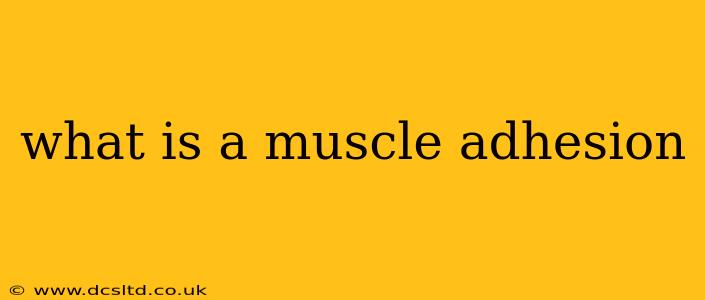Muscle adhesions are essentially sticky bands of scar tissue that form between muscle fibers. These adhesions restrict the smooth, gliding motion of muscles, leading to pain, stiffness, and reduced range of motion. Think of it like Velcro clinging to your muscle tissues – preventing them from moving freely. Instead of sliding past each other easily, the muscle fibers become stuck together, creating knots and restricting normal function. This is a common problem affecting athletes, individuals with sedentary lifestyles, and anyone experiencing muscle injury or inflammation.
What Causes Muscle Adhesions?
Several factors contribute to the formation of muscle adhesions. Understanding these causes is crucial for preventing and treating them effectively.
-
Muscle Injury: Trauma, strains, sprains, or even microscopic tears in muscle tissue can trigger the body's healing response, leading to scar tissue formation and adhesions.
-
Inflammation: Chronic inflammation, often associated with conditions like fibromyalgia or autoimmune diseases, can disrupt the normal healing process, resulting in the development of adhesions.
-
Repetitive Strain: Performing the same movements repeatedly, like typing on a computer or engaging in repetitive sports movements, can cause micro-tears and inflammation, ultimately leading to adhesions.
-
Poor Posture: Maintaining poor posture for prolonged periods strains certain muscle groups, increasing the risk of adhesions.
-
Lack of Flexibility and Movement: Inactivity and a lack of stretching allow muscles to tighten and become more prone to adhesion formation.
What are the Symptoms of Muscle Adhesions?
Identifying muscle adhesions can sometimes be challenging, as symptoms can vary widely depending on their location and severity. Common symptoms include:
-
Localized Pain: Often a dull, aching pain that may worsen with movement or pressure.
-
Muscle Stiffness and Tightness: Difficulty stretching or moving the affected muscle normally.
-
Reduced Range of Motion: Inability to fully extend or flex the affected joint.
-
Muscle Knots (Trigger Points): Palpable lumps or knots within the muscle.
-
Referred Pain: Pain may radiate to other areas of the body, making it difficult to pinpoint the exact location of the adhesion.
How are Muscle Adhesions Diagnosed?
Diagnosing muscle adhesions often involves a physical examination by a healthcare professional, such as a physician, physical therapist, or massage therapist. They will assess your range of motion, palpate the affected area for knots and stiffness, and review your medical history. Imaging techniques like ultrasound or MRI may be used in some cases, particularly if other conditions are suspected.
How are Muscle Adhesions Treated?
Treatment for muscle adhesions focuses on breaking up the scar tissue and restoring normal muscle function. Common approaches include:
-
Massage Therapy: Skilled massage therapists can use various techniques to help break down adhesions and improve tissue mobility.
-
Myofascial Release: This technique involves applying gentle, sustained pressure to release tension in the fascia (the connective tissue surrounding muscles).
-
Stretching and Exercise: Regular stretching and targeted exercises help improve flexibility, range of motion, and reduce muscle tightness.
-
Foam Rolling: Self-massage using a foam roller can help address muscle tightness and adhesions.
-
Heat and Cold Therapy: Applying heat or ice can help reduce pain and inflammation.
Can Muscle Adhesions be Prevented?
Yes, taking proactive steps can significantly reduce your risk of developing muscle adhesions:
-
Regular Stretching: Incorporate regular stretching into your routine to maintain flexibility and prevent muscle tightness.
-
Proper Exercise: Engage in regular physical activity that challenges your muscles without causing injury.
-
Maintaining Good Posture: Be mindful of your posture throughout the day to prevent muscle strain.
-
Proper Warm-up and Cool-down: Always warm up before exercising and cool down afterward to prevent muscle injury.
-
Addressing Injuries Promptly: Seek professional medical advice for any muscle injuries to prevent the development of adhesions.
Understanding muscle adhesions is key to addressing muscle pain and stiffness effectively. By understanding their causes, symptoms, and treatment options, you can take control of your musculoskeletal health and prevent future problems. Remember to consult with a healthcare professional for diagnosis and personalized treatment.
